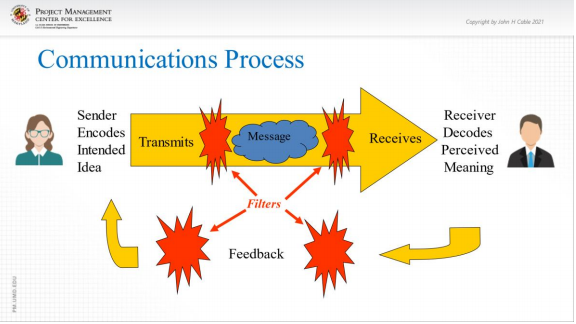As the pandemic has forced us to meet virtually, I now hear complaints about being “Zoomed out”! People are past the fascination of learning how to physically setup and participate in a video conference and generally probably know the mechanics of proper lighting, camera angles, backgrounds, etc. But do they know the rudiments of running a meeting, starting with do we actually need a meeting?
There are many established forms of communication including written memos & reports, emails, telephone calls, and text messages are some of the examples. Each has an appropriate and effective use. We will go into this in much greater depth in an upcoming article on project communication. For now, the focus is either face-to-face meetings or virtual ones (ie videoconferences).
Do you spend too much time in meetings? How many hours per week do you spend? Are most of the meetings you attend engaging and energizing, or just a waste of time? Have you ever thought about how much labor cost there is in a meeting and how much money is wasted if the meeting isn’t productive? Is the meeting worth it? When do you actually need the meeting? We have all experienced the regular meeting that is a carryover from the past, when it may have been needed or served a purpose. Or the non-routine meeting that wastes time and does not accomplish anything!
To view the recording of the FREE webinar, scroll down to the bottom of this article.
There are many different types of meetings, and they can serve a valuable purpose when planned and managed properly. Do you know how to effectively plan and manage them? This article will discuss both virtual and in-person meetings. The concepts for success are the same!
The first question you have to ask is “Do we need to meet?” Meetings should be used sparingly and only when necessary, but they certainly play an important role in communications and team building. Post-pandemic, video conferences will work very well for many purposes, but there will still be times when a face-to-face meeting may be essential.
Learning to be comfortable in both mediums directly leads to improved productivity. The primary value of face-to-face meetings is the ability to read body language and have side conversations at breaks or over lunch.
For the purposes of this article, I have organized the elements of a meeting into the following sections: Plan the Meeting, During the Meeting, and After the Meeting. We will discuss each one below.
Plan the Meeting
The starting point for a successful meeting is to plan the event! My favorite saying is that “Failing to Plan is Planning to Fail.” This does not, however, mean to jump into a degree of detail that is inappropriate or makes assumptions that are not supported by the facts and information available.
For simplicity, there are three basic types of meetings: 1) a directed exchange; 2) a query-based session; and 3) collaborative solutions.
Directed Exchange (Push)
This type of meeting is one in which someone is to give instructions. It pushes information out! The speaker is not asking for feedback or discussion but simply providing a direction. Any associated discussion is limited to the purpose of clarifying what is intended. This type of meeting can often be eliminated and replaced with a memo, some other written directive, or perhaps even a pre-recorded video.
Query-Based (Pull)
This type of meeting is one in which the participants exchange information, give feedback, or coordinate. They are often short gatherings, possibly only 15 minutes, simply to exchange information and coordinate activities or assignments.
Collaborative Solutions
This meeting is intended for the group to plan, analyze, or solve problems. This meeting has the advantage of getting everyone’s input, draw out the best ideas, and develop solutions to problems. A benefit is that, if run properly, everyone that participates generally “owns” the outcome and should have buy-in for the direction that takes place after the meeting.
Typical types of meetings in the project management world might include planning the project; project kickoff; periodic check-in; status review, technical review; problem solving; or stakeholder coordination, to name a few.
Once the purpose and type of meeting is understood, then the next important step is to plan. Some considerations include:
- Who needs to be included?
- How much time is needed?
- What is the optimum time of day to conduct the meeting?
- If meeting in person, select a meeting room that is fit for the purpose of the meeting and has the space and technology to support the activities planned.
- What information do the participants need to prepare for the meeting?
- Provide read-ahead information in advance with sufficient time to prepare.
- Provide the agenda in advance. Prioritize 1st things 1st.[1]
If the meeting is virtual, be sure you know how to use any of the particular features of the platform you are expecting to use. For example, in Zoom, using the polling feature or the breakout rooms is easy but be sure you know how to do it. Practicing ahead of time is always a good idea to make sure everything runs smooth during the meeting.
If the meeting is in person, make sure the room is suitable, has the features you may want (white board, flip charts, markers, etc), that the lighting, HVAC, and technology is all in good working order and that you know how to use / control everything. Nothing is more irritating to meeting participants than to have to waste time waiting for you to try and get something to work. Valuable time may be lost, particularly if on a tight schedule.
A feature that I always like for in-person meetings is if the host has provided water, coffee, tea and perhaps light refreshments for the meeting participants. It is a nice touch!
During the Meeting
- Respect others time and always start on time. If the meeting is virtual open the VC room up 10 minutes early to allow participants to sign in. It is very easy to slip into the mode of waiting for latecomers to surface but this is disrespectful of participant’s time. Do not waste it. Office traditions of always starting late can be changed and it only takes a few times of starting on time for people to acclimate. My rule is 5 minutes early is on time!
- If needed, designate a note-taker so that you can focus on managing the meeting. Don’t try to manage the meeting and take notes. Online using Zoom, just record the meeting.
- Start the meeting by reviewing the agenda and asking for any amendments. Review the purpose of the meeting.
- Stick to the agenda and for each item:
-
- State the issue.
- Ask participants for their views. Encourage open discussion.
- Keep focused on the topic. Use a “parking lot” for off topic ideas.
- Seek to understand, and if conflicts erupt, work to resolve them.
- Seek consensus and make decisions.
- Facilitate do not dominate!
- Do not overrun the time scheduled, unless agreed to by participants.
- Don’t be afraid to finish early – remember, respect time!
- Summarize decisions and assignments.
- Use an action item list with citing task, person responsible, and due date. Many organizations keep preprinted action item notepads available.
Example Action Item List

Communications
The purpose of a meeting is to have some type of communication between the parties. This exchange of information has the risk of misunderstanding. Remember the image:

What do you see when you look at this? Is it a vase? Is it two opposing faces? Perhaps this second image clarifies:

The point is that we can all look at the same information but see it differently! The same is true for listening. The basic communication model, shown below, consists of two parties, a sender and a receiver.
The sender encodes a message, transmits it, and the receiver decodes the perceived meaning. But, based on the filters (real experience and bias) each has, the sender may have meant one thing, but unfortunately the receiver understood something entirely different.
Research suggests that in face to face (including video conferences) meetings only about 7% of the content is transmitted verbally and 93% is contained in tone of voice, body language and posture.[2]
Effective communications build trust and nurtures efficiency. Remember the communication flow process and strive to keep your messages simple and easy to understand. Half of effective communication is listening and striving for understanding. Remember this when managing any type of meeting.

After the Meeting
- Circulate notes or key point minutes as soon as possible. These are not transcripts.
- Coordinate with others as appropriate.
- Implement decisions.
- Schedule action items and check in with others responsible for items.
- Follow-up!
Some Closing Thoughts
In the highly regarded book “The 7 Habits of Highly Effective People” by Stephen Covey[3], he proposes eight principles for managing meetings:
- Be proactive – initiative and desire to succeed.
- Begin with the end in mind – clear objectives.
- Put first things first – set priorities.
- Think win/win – cooperation & collaboration.
- Seek to understand before being understood – listening and questioning.
- Synergize – facilitating group dynamics.
- Sharpen the saw – continually improve the process.
- Lead with respect – suspend judgement.
I like to review these points when preparing for a meeting. Thinking about these in our effort to continually improve the efficiency and effectiveness of our meetings is a constant journey because the variables always change. However, it can mean that meetings are not boring and a waste of time but, instead, achieve the goal with a positive outcome.
Two recommendations for Reading:
- “The 7 Habits of Highly Effective People,” by Stephen R. Covey, Simon & Schuster, 1989
- “The One Minute Manager”, by Kenneth Blanchard, PhD and Spencer Johnson, M.D., Berkley Books, 1981
Article References:
[1] The 7 Habits of Highly Effective People, Stephen R. Covey, Simon & Schuster, 1989
[2] Dr. Albert Mehrabian’s “Rule of Personal Communication” Nagesh Belludi, October 4, 2008
[3] The 7 Habits of Highly Effective People, Stephen R. Covey, Simon & Schuster, 1989
This article appeared in PM World Journal, Vol. X, Issue IV, April 20201.
John Cable, Director of the Project Management Center for Excellence, presented a 25 minute webinar on Managing Effective Meetings. Watch the video below.
Posted by Kathy Frankle on April 9, 2021

 Data Analytics for the Project Manager
Data Analytics for the Project Manager